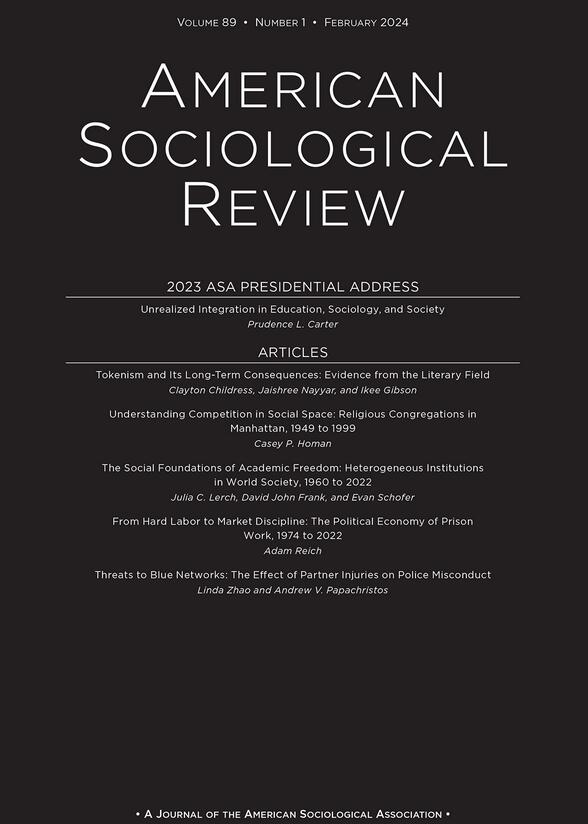工作环境中的种族不平等
IF 6.2
1区 社会学
Q1 SOCIOLOGY
引用次数: 2
摘要
这篇文章探讨了工作环境中的种族分层。研究不平等的学者早就发现了工资和职业成就方面的种族差异,但工人的职业生涯和幸福感也受到工作环境因素的影响,包括公司文化、管理风格和工作与生活的平衡。我认为有两个过程可能导致公司工作环境中的种族不平等:(1)由于排他性做法而导致的员工分类;(2)职业和地理位置上的种族差异的溢出效应。为了验证这一点,我收集了一个独特的公司层面的数据集,由100万名员工的评论组成,涵盖了美国大多数大中型公司。我发现,拥有更多黑人员工的公司在管理质量、企业文化和工作与生活平衡方面得分较低,而拥有更多亚洲员工的公司在这些方面得分较高。然而,当控制职业、行业和地理因素时,亚裔员工的优势消失,而黑人员工的劣势仍然存在,这表明公司层面的员工分类过程在起作用。与此相一致的是,我发现黑人员工的劣势在种族态度更保守、职场种族歧视更普遍的地区最为明显。然后,我用两个完全不同的数据源重复了主要的发现。总之,这些结果强调了工作环境中的种族不平等,这是工作场所不平等的一个被忽视但重要的方面。本文章由计算机程序翻译,如有差异,请以英文原文为准。
Racial Inequality in Work Environments
This article explores racial stratification in work environments. Inequality scholars have long identified racial disparities in wage and occupational attainment, but workers’ careers and well-being are also shaped by elements of their work environment, including firm culture, managerial style, and work-life balance. I theorize two processes that could lead to racial inequality in firms’ work environments: (1) employee sorting due to exclusionary practices, and (2) spillover from racial differences in occupation and geographic location. To test this, I gathered a unique firm-level dataset composed of one million employee reviews, covering most large and medium-sized firms in the United States. I show that firms with more Black employees score lower for managerial quality, firm culture, and work-life balance, and firms with more Asian employees score higher on these dimensions. However, Asian employees’ advantage disappears when controlling for occupation, industry, and geography, whereas Black employees’ disadvantage persists, suggesting that the process of firm-level employee sorting is at work. Consistent with this, I find that Black employees’ disadvantage is strongest in areas with more conservative racial attitudes and more prevalent workplace racial discrimination. I then replicated the main findings using two entirely different data sources. Together, these results underscore racial inequality in work environments, an overlooked but important dimension of workplace inequality.
求助全文
通过发布文献求助,成功后即可免费获取论文全文。
去求助
来源期刊

American Sociological Review
SOCIOLOGY-
CiteScore
13.30
自引率
3.30%
发文量
35
期刊介绍:
The American Sociological Association (ASA) is a non-profit membership association established in 1905. Its mission is to advance sociology as a scientific discipline and profession that serves the public good. ASA is comprised of approximately 12,000 members including faculty members, researchers, practitioners, and students in the field of sociology. Roughly 20% of the members work in government, business, or non-profit organizations.
One of ASA's primary endeavors is the publication and dissemination of important sociological research. To this end, they founded the American Sociological Review (ASR) in 1936. ASR is the flagship journal of the association and publishes original works that are of general interest and contribute to the advancement of sociology. The journal seeks to publish new theoretical developments, research results that enhance our understanding of fundamental social processes, and significant methodological innovations. ASR welcomes submissions from all areas of sociology, placing an emphasis on exceptional quality.
Aside from ASR, ASA also publishes 14 professional journals and magazines. Additionally, they organize an annual meeting that attracts over 6,000 participants. ASA's membership consists of scholars, professionals, and students dedicated to the study and application of sociology in various domains of society.
 求助内容:
求助内容: 应助结果提醒方式:
应助结果提醒方式:


